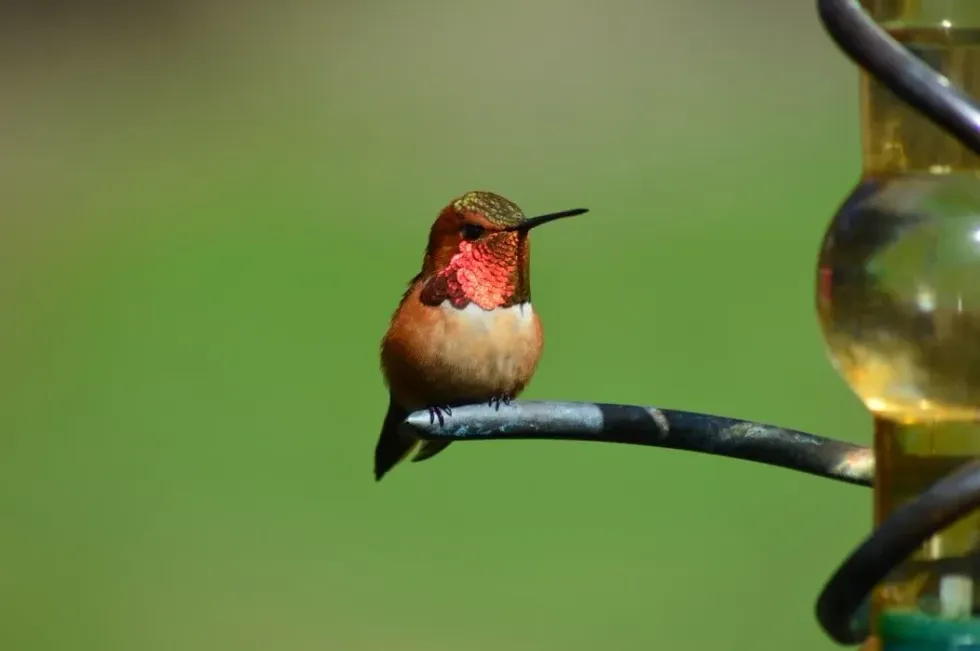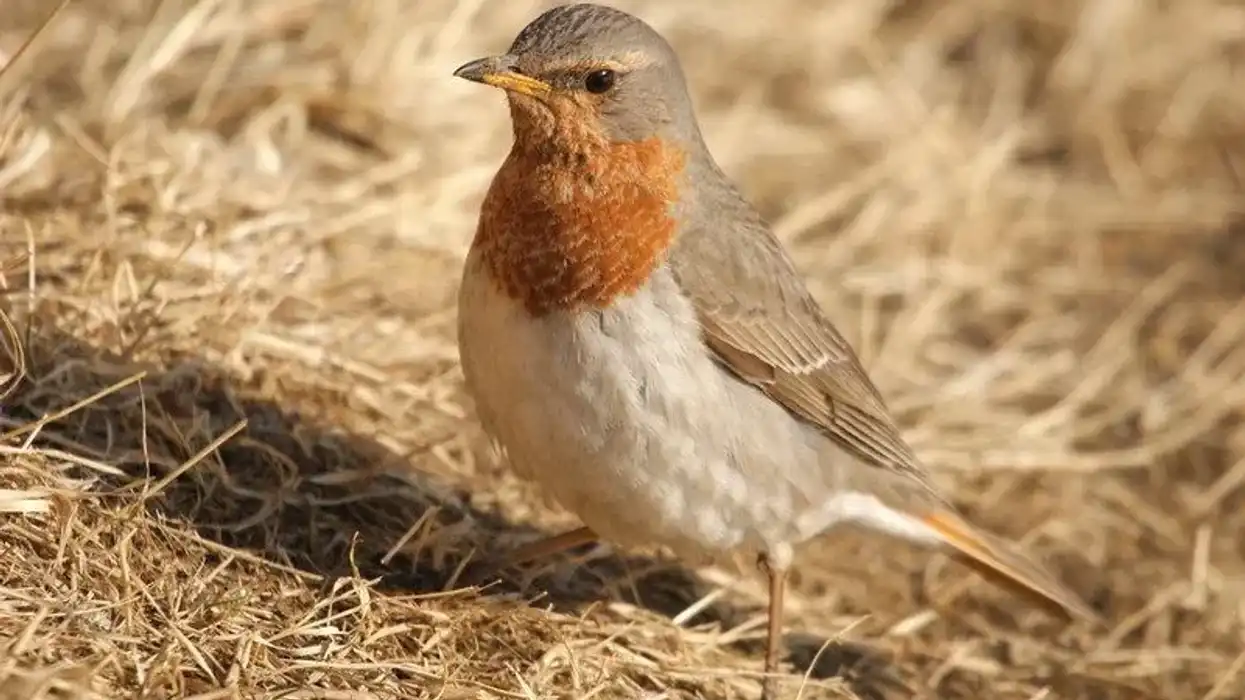The rufous hummingbird is mainly a North-American hummingbird, famous for its flying skills and long-distance migration. The rufous hummingbird (Selasphorus rufus) is one of the seven hummingbird species under the genus Selasphorus. These birds can be found across a vast range of land around the year, but mainly they prevail in the western part of North America.
They are nectar feeders; and prefer to stay close to flowers like lilies, mints, larkspurs, heaths, fireweed, and Indian paintbrush for the nectar, and also for the visiting insects. They catch these insects from the air, or pick them from their wing or spider-webs, and consume them.
They are found in high places like mountain meadows at more than 12,000 feet elevation from sea level during migration.
Rufous hummingbirds are one of the most aggressive and angry American birds. They tirelessly chase each other off and also other species of hummingbirds, even those who are bigger than them.
Males fiercely protect their habitat and breeding grounds but show no such enthusiasm in defending their offspring.
The female birds make their nests in 25-30 feet or more high coniferous or deciduous trees like fir, spruce, western cedarwood, maples, hemlock, or birch. They camouflage their nests with lichens and moss and protect their eggs and chicks until they are capable of taking flight for migration.
If you are interested in birds, check out the owl and the tufted titmouse.
Rufous Hummingbird Interesting Facts
What type of animal is a rufous hummingbird?
The rufous hummingbird is a species of North-American hummingbird.
What class of animal does a rufous hummingbird belong to?
The rufous hummingbird belongs to class Aves, which means it is a bird.
How many rufous hummingbirds are there in the world?
There are estimated to be around 400,000 rufous hummingbirds in the world.
Where does a rufous hummingbird live?
Rufous hummingbirds live in the open woodlands of western North America.
What is a rufous hummingbird's habitat?
Rufous hummingbirds mainly live in oak, pine, juniper woods, mountain meadows, and shrubby areas. They like hilly locations. Their habitat is usually several thousand feet above sea level. During winter, they stay in places where flowers are available.
Who do rufous hummingbirds live with?
These birds are mostly solitary in nature. They are remarkably aggressive as well. Whenever they are not going after food, they chase off other species of hummingbirds.
How long does a rufous hummingbird live?
The longest lifespan recorded was eight years 11 months.
How do they reproduce?
The breeding season of the rufous hummingbird spans from April to July, with May being the peak. Their breeding grounds are usually in southern Alaska and the Pacific North West.
The males are polygynous, i.e. an adult male mates with several females during the breeding season.
The male reaches the desired breeding territory two to three weeks prior to the females. He attracts a female by a unique mating display that involves climbing high in the air, doing a sharp dive, and then abruptly pulling out of the dive when it comes within two or three inches of the female.
The male rufous hummingbird flutters his wings at a rate of 200 times per second during this behavior, which creates a distinct buzzing sound.
The female expresses her approval by showing the white tips of her tail. Then copulation takes place which lasts for only three to five seconds.
The female rufous hummingbird nests in well-protected bushes and vines, and high trees by weaving moss, lichens, leaves, and spider webs together. Usually, each female lays two eggs.
The eggs take 12-14 days on average to hatch; the hatchlings leave the nests after one week. The females are fiercely protective of their nests, but the male birds play no role in raising the offspring or defending them from predators or any other kind of harm.
What is their conservation status?
The conservation status of rufous hummingbirds is Least Concern, as per IUCN Red List. As per the latest reports indicating their population, the rufous hummingbird numbers have been known to be ample in keeping with the current times.
Rufous Hummingbird Fun Facts
What do rufous hummingbirds look like?

An adult male rufous hummingbird is orange in color apart from the white breast and red throat. The females are green-white, with orange spots on the throat and a white-tipped dark tail.
The baby birds are also green-white. Adults are 2.8-3.6 in (7.3-9.1 cm) in length from the tip of the beak to the end of the tail, and approximately 4.3 in (11 cm) inch wingspan.
Adult males are a little smaller than their female counterparts. Rufous hummingbirds, mainly females and also males if they are green-backed, can easily be mistaken with another species, commonly named Allen's hummingbird, because of their striking similarity.
A distinct notch in the second tail feather (rectrix) of rufous hummingbirds can be an identifying feature in the rufous hummingbird vs Allen's hummingbird comparison. These birds got their name from the rufous color, which means brownish-red.
How cute are they?
Rufous hummingbirds are really cute and colorful as far as looks are concerned. However, their nature is not so sweet.
How do they communicate?
Rufous hummingbirds prefer to be on their own. Their communication mainly involves conflict; like males protecting their respective territories for nectar and breeding grounds, fighting each other off for mating partners and chasing off other hummingbirds.
During courtship, male rufous hummingbirds perform their precarious dive and buzzing sound of the wing and the females reciprocate by showing the white tips of their tail.
How big is a rufous hummingbird?
The average length of adult rufous hummingbirds is 2.87-3.58 in (7.3-9.1 cm). They are usually similar-sized to a sparrow, if not smaller.
How fast can a rufous hummingbird fly?
Their usual speed of flying is around 25 miles per hour; but during the courtship, it can reach up to 50 miles per hour.
How much does a rufous hummingbird weigh?
The weight of the adult rufous hummingbirds range s from 0.097-0.1 oz (2.8-4.0 g).
What are their male and female names of the species?
The male and female names of the species do not have separate common names and are generally referred to as rufous hummingbirds.
What would you call a baby rufous hummingbird?
Like most other baby birds, a baby rufous hummingbird is also called a chick.
What do they eat?
The rufous hummingbird diet mainly includes nectar and insects. Nectar of several different flowers like honeysuckle, black locust, horsemint, and scarlet sage is their prime source of energy. To satisfy their requirements for protein and fat, rufous hummingbirds consume insects like flies, ants, small beetles, and wasps. They catch them mid-air or from spider webs.
Are they friendly?
Rufous hummingbirds are one of the most aggressive birds, and they do not like to socialize at all.
Would they make a good pet?
Rufous hummingbirds are too wild in nature to be kept as a pet. The fact that they display migratory behavior and undertake extensive migration also does not help matters. It would thus be extremely difficult to keep them in a house or a cage as they by nature love to be free and out in the open.
Did you know...
Rufous hummingbirds have the longest migration of any hummingbird species.
Rufous hummingbirds molt yearly during June-September. It starts on breeding grounds and ends along the coast of the Gulf of Mexico.
Their eggs are white in color and 0.5 inches in size.
Rufous hummingbirds beat their wings at a rate of 50 times per second normally. During mating, it can be as fast as 200 times per second. This fast beating of wings is the reason that a rufous hummingbird sounds as if it is humming. This is why these birds are known as hummingbirds.
As they eat nectar from flowers, rufous hummingbirds help in pollinating nearly 130 plant species.
They can clean and waterproof their feathers by using an oil from a gland positioned at the base of their tail.
In a resting period, a rufous hummingbird's heart beats 480 times per minute. It can increase to 1260 beats per minute in a state of excitement.
Rufous hummingbirds are attracted to red and tubular flowers; hence, they come to the hummingbird feeders in the garden. Hummingbird feeders are devised to feed the hummingbirds artificially.
Owls, hawks, weasels, merlins, and sometimes spiders prey on this bird.
Male rufous hummingbirds fight in midair to compete for female partners.
They can consume food for up to three times their body weight. They prefer many small meals throughout the day over a few large meals.
They like sunbathing.
Rufous hummingbirds have two sets of small vocal muscles in their trachea, instead of the long sound-producing muscles between the windpipe and chest bone, which are seen in other birds.
How far do rufous hummingbirds migrate?
Rufous hummingbirds are migratory birds and are capable of a longer flight than any other hummingbird species. They can fly 3000-4000 miles during migration.
In summer, they stay in western and coastal North America with their breeding grounds being in Alaska, which is further than any other North-American hummingbird would go. After the breeding season, their migration takes place through the Rocky Mountains during May-September to the gulf coast in western Mexico and spends the winter there.
What is the oldest recorded rufous hummingbird?
The oldest recorded rufous hummingbird lived for eight years and 11 months.
Here at Kidadl, we have carefully created lots of interesting family-friendly animal facts for everyone to discover! Learn more about some other birds including the shrike and the summer tanager.
You can even occupy yourself at home by drawing one of our rufous hummingbird coloring pages.










